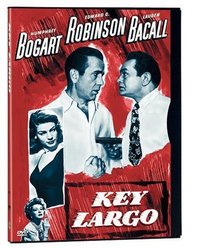| If you like your good guys and bad guys in black and white with effective shades of gray then Key Largo is for you, and there’s a lot of star power to boot. The film was directed by John Huston and featured Humphrey Bogart, Lauren Bacall, Edward G. Robinson, Lionel Barrymore and Claire Trevor (who won an Oscar for Best Supporting Actress). There’s even a cameo by Jay Silverheels, TV’s Tonto from the Lone Ranger.
While the movie is described as a film noir thriller it’s not that noir-ish, and while there’s plenty of action it isn’t as suspenseful as you might expect. Still, it’s a very entertaining drama, well-acted and well-told and set against the backdrop of post-World War II America. Bogie plays Frank McCloud, an idealistic but jaded war veteran who travels to Key Largo to visit the crippled father (Barrymore) and widow (Bacall) of George Temple, a friend who served under him in Italy. They are good, decent people and he tells them about George, saying, “You’d have been proud of him, like every man in his regiment. With good reason. It wasn’t just a matter of doing his duty. He was always looking for a way to do more. And finding it. George was a born hero, Mr. Temple. He couldn’t imagine his own death. Only dishonor.” |
 |
The Temple family owns a hotel, which also happens to have some unsavory guests in the person of Robinson, as gang-boss Johnny Rocco, and his assorted henchmen who are there to close a counterfeiting deal. Oh, and did I mention a hurricane is on the way?
As in Casablanca, Bogart plays a good guy who just wants to mind his own business and not get involved in any causes, but who ultimately can’t ignore his conscience. A subtext to the story that younger viewers are likely to miss is the postwar disillusionment Frank feels after sacrificing so much to defeat evil and then returning home to find things little changed, as ultimately manifested by Rocco. (Talk about great acting – one of the most powerful scenes is when Robinson is whispering to Lauren Bacall, even though she doesn’t speak and you can’t hear a word he is saying).
Thrown together in close quarters due to the storm, the Frank and Rocco naturally clash but when pressed to the sticking point Frank initially backs down to preserve his life, saying “One more or one less Johnny Rocco in the world isn’t worth dying for” even though it costs him the respect of the Temples (who apparently prefer dead heroes to survivors). It also costs him some of his own self-respect but he ultimately regains all when he realizes that “a fighter can’t walk away from a fight” and goes against doing the sensible because “your head says one thing but your whole life says another.”
Questions to answer:
- Was Frank’s bigger struggle with himself or with Rocco?
- Is “one more or one less Johnny Rocco in the world” worth dying for? How would you balance that equation?
- What is the one thing in the movie that Rocco fears, and why? Is this symbolic on a spiritual level?
- What do you think Nora meant when she said, “When you believe like George believed, maybe dying isn’t so important.”
Points to ponder: From the dialog in the story, why do you think Frank drifted between so many jobs after the war. What do you think his expectations were when the war was over, and how did he adapt to the reality?
Great quote:
“You’ve got to be lying. 800 people swept out to sea in a hurricane? Who would ever live here again if that really happened?”
About Fundamentals in Film: this series began as a class I taught to junior high and high school boys as a way to use the entertainment media to explore concepts of honor, honesty, duty and accountability. The movies were selected to demonstrate these themes and as a contrast to television that typically either portrays men as Homer Simpsons or professional wrestlers, with little in between those extremes. I wrote questions and points to ponder for each movie to stimulate discussion and to get the boys to articulate their thoughts and reactions to each movie. I offer this series here on this blog for the benefit of parents or others looking for a fun but challenging way to reinforce these concepts in their own families or groups. As the list of films grows each week, feel free to use these guides and to mix and match movies according to your interests or those of your group. I’m also always open to suggestions for other movies that can be added to the series.











